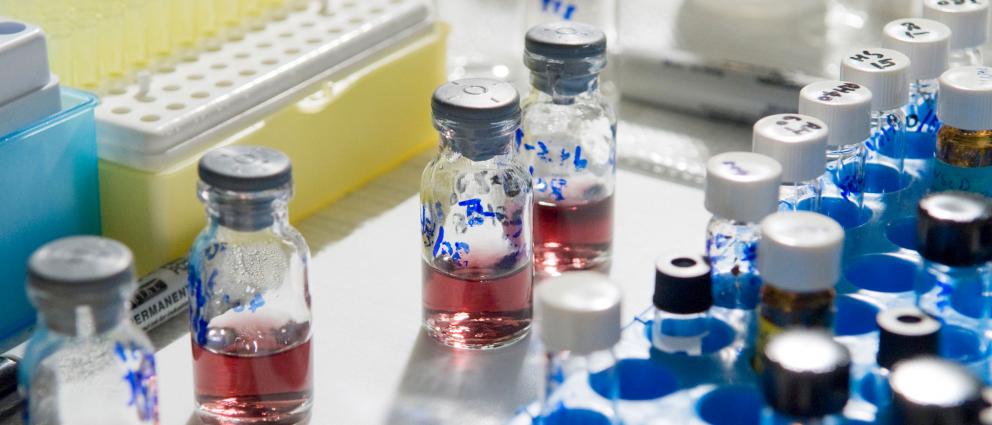Research Overview—
With 30+ years of experience in industry, academic pursuits will focus on a problem statement driven research program. The labs will focus on Physical Pharmacy and Drug Delivery (P2D2) as it relates to understanding physicochemical properties of the drug and the excipients that dictate formulation, process design and bioperformance. The P2D2 Labs will have the capability to produce, process, and characterize small molecule, peptide, and protein therapeutics as formulated through excipient-stabilized amorphous formulations for either oral or parenteral delivery.
- Apply processing capabilities based on mini-lab scale spray-drying, lyophilization and vacuum evaporation to generate amorphous materials for investigation, characterization and enhanced delivery of peptides and small molecules.
- Control dissolution behavior and modulate bioperformance of amorphous solid dispersions (ASD) through careful excipient selection. Examine the ability to enhance oral absorption or normalize a drug’s molecular physicochemical properties through generation of amorphous drug formulated in solid dispersions.
- Define ASD stability/dissolution for ternary systems of drug, polymer and surfactant (e.g. DRUG:HPMCAS:SURFACTANTS and DRUG:POLYMER:PHOSPHOLIPIDS) as they become quaternary systems upon water uptake during GI transit. Determine the impact of ASD excipient selection and ASD composition for physical stability and dissolution of both peptide and small molecule drugs.
- Examine the ability of zeolites/silicas (library access to large number of zeolites/silicas) and mesoporous silica to stabilize the “amorphous or adsorbed” state during storage, insuring desorption upon contact with GI media.
- Explore the role of excipients in oral modulated release formulations prepared by mini-lab scale fluidized bed coating of ASD spray-layered multi-particulate beads. Couple solubilizing excipients (polymers, surfactants, lipids, cyclodextrins) to create spray layered ASD formulations whose release is subsequently modulated by spray layering of rate controlling polymers for desired rates or locational release in the GI tract.
- Develop tools to examine the role of solubilized formulations at the physiological interface, understanding the advantages and limitations of excipients used to facilitate supersaturation and para/trans cellular permeation.
- Identify in vitro cell-based methods to screen for the propensity of interstitial and intracellular drug precipitation/crystallization when repeatedly exposed to supersaturated extracellular concentrations.
- Understand more thoroughly the role of intestinal media (bile acid mixed bile acids) in solubilizing versus sequestering drugs and/or impacting the precipitation rates of drugs.
- Explore the role of mucin in accessing the cellular layers, particularly for ionizable compounds.
- Evaluate the utility of specific cadherin binders (linear & cyclic peptides) to transiently open cellular tight junctions, permitting oral delivery of poorly permeable small molecules, peptides and proteins.
- Utilize prodrug strategies to alter the physicochemical properties of a drug, to more easily solublilize them in bile acid mixed micelles (BAMM), formulate them into absorption-enabled formulations and enhance their permeability, solubility or supersaturatability.
- Examine the co-delivery and co-localization in the GI tract of permeability enhancing peptides and low permeability drugs (both poorly soluble themselves) using spray-layered and coated multiparticulates.
- Couple drug solubilization strategies and ASD, specifically targeting localized drug delivery to the lower GI tract and mesenteric lymph. The focus will be for localized, not systemic, treatment of infectious bowel disease (IBD) and tumors with extensive mesenteric lymph bed involvement.
- Identify mechanisms of, and mitigation strategies for, instability of peptide/protein drugs in lyophilized, foam-dried, spray-dried and spray-layered solids during processing, storage and residence time at the administration site.
- Develop highly hydrated solids as high concentration solution models to study peptide/protein stability during dehydration, rehydration, and dissolution/diffusion steps. Develop models to examine interfacially- induced destabilization of peptides/proteins during tangential filtration processing and storage.
- Develop models to study the role of formulation composition and design on peptide/protein stability and release (dissolution/diffusion) from drug-depots at 37°C, mimicking subcutaneous depot release or dosage form release of peptides and proteins following hydration.
- Examine the ability of zeolites/silicas (library access to large number of zeolites/silicas) to stabilize the “amorphous or adsorbed” state of proteins, insuring adequate desorption of intact protein.
Selected Publications —
Representative Publications
Michael J. Hageman Representative Publications (NCBI)
Editorial Activities
Editor for the Journal of Pharmaceutical Sciences
Journal of Pharmaceutical Sciences Editorial Board
Book - Prodrugs: Challenges and Rewards
Prodrugs: Challenges and Rewards
Editors: Stella, V., Borchardt, R., Hageman, M., Oliyai, R., Maag, H., Tilley, J. (Eds.)
Book - Optimizing the "Drug-Like" Properties of Leads in Drug Discovery
Optimizing the "Drug-Like" Properties of Leads in Drug Discovery
Editors: Borchardt, R., Kerns, E., Hageman, M., Thakker, D., Stevens, J. (Eds.)

